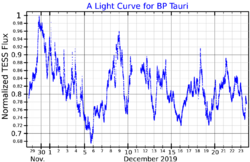Astronomy:BP Tauri
Coordinates: ![]() 04h 19m 15.8343s, +29° 06′ 26.9295″
04h 19m 15.8343s, +29° 06′ 26.9295″
| Observation data Equinox J2000.0]] (ICRS) | |
|---|---|
| Constellation | Taurus |
| Right ascension | 04h 19m 15.8343s[2] |
| Declination | +29° 06′ 26.9295″[2] |
| Apparent magnitude (V) | 12.12 |
| Characteristics | |
| Evolutionary stage | pre-main-sequence star |
| Spectral type | K5 |
| Apparent magnitude (G) | 11.460[3] |
| Variable type | T Tau |
| Astrometry | |
| Radial velocity (Rv) | 15.76±0.13 km/s |
| Proper motion (μ) | RA: 8.889[3] mas/yr Dec.: -26.011[3] mas/yr |
| Parallax (π) | 7.8494 ± 0.0362[3] mas |
| Distance | 416 ± 2 ly (127.4 ± 0.6 pc) |
| Details | |
| Mass | 1.24+0.25−0.32[4] M☉ |
| Radius | 2.0[5] R☉ |
| Luminosity | 0.93[5] L☉ |
| Surface gravity (log g) | 4.32±0.14[6] cgs |
| Temperature | 3640+94−92[6] K |
| Rotational velocity (v sin i) | 11.4+0.25−0.55[6] km/s |
| Age | 6±4[4] Myr |
| Other designations | |
| Database references | |
| SIMBAD | data |
BP Tauri is a young T Tauri star in the constellation of Taurus about 416 light years away, belonging to the Taurus Molecular Cloud.
Properties
BP Tauri is still accreting mass at the low rate of 9×10−10 M☉ and 1.6×10−7 M☉/year,[7] as evidenced by X-rays produced by infalling matter,[8] and may be still in the process of spin-up.[9] Its chromospheric magnetic fields are rather strong at 2.5+0.15−0.16 kilogauss,[6] and contains strong non-dipole components.[10] The star is producing 40% of its luminosity via the energy released by accretion.[5]
Suspected companions
There were two suspected stellar companions to BP Tauri on projected separations 3.00 and 5.45 arcseconds.[11] These were proven to be a background stars not related to BP Tauri with Gaia data though.[12][13]
Protoplanetary system
The star is surrounded by a protoplanetary disk. The disk is strongly depleted in carbon and carbon monoxide.[14]
| Companion (in order from star) |
Mass | Semimajor axis (AU) |
Orbital period (days) |
Eccentricity | Inclination | Radius |
|---|---|---|---|---|---|---|
| protoplanetary disk | 0–120[15] AU | 30[14]° | — | |||
Variability
BP Tauri varies in brightness, producing a strong flares due to unsteady accretion[5] held by stellar magnetic field. The lightcurve period is variable from 6.1 to 7.6 days, and quiescent periods without variability are also known.[16]
References
- ↑ "MAST: Barbara A. Mikulski Archive for Space Telescopes". Space Telescope Science Institute. https://mast.stsci.edu/portal/Mashup/Clients/Mast/Portal.html.
- ↑ 2.0 2.1 "V* BP Tau". SIMBAD. Centre de données astronomiques de Strasbourg. http://simbad.u-strasbg.fr/simbad/sim-basic?Ident=V%2A+BP+Tau.
- ↑ 3.0 3.1 3.2 3.3 Brown, A. G. A. (2021). "Gaia Early Data Release 3: Summary of the contents and survey properties". Astronomy & Astrophysics 649: A1. doi:10.1051/0004-6361/202039657. Bibcode: 2021A&A...649A...1G. Gaia EDR3 record for this source at VizieR.
- ↑ 4.0 4.1 Simon, M.; Dutrey, A.; Guilloteau, S. (2000), "Dynamical Masses of T Tauri Stars and Calibration of Pre–Main-Sequence Evolution", The Astrophysical Journal 545 (2): 1034–1043, doi:10.1086/317838, Bibcode: 2000ApJ...545.1034S
- ↑ 5.0 5.1 5.2 5.3 Errico, L.; Lamzin, S. A.; Vittone, A. A. (2001), "UV spectra of T Tauri stars from the HST and IUE satellites: BP Tau", Astronomy & Astrophysics 377 (2): 557–565, doi:10.1051/0004-6361:20011108, Bibcode: 2001A&A...377..557E
- ↑ 6.0 6.1 6.2 6.3 Flores, C.; Connelley, M. S.; Reipurth, B.; Boogert, A. (2019), "Measuring the Magnetic Field of Young Stars Using iSHELL Observations: BP Tau and V347 Aur", The Astrophysical Journal 882 (2): 75, doi:10.3847/1538-4357/ab35d4, Bibcode: 2019ApJ...882...75F
- ↑ Long, M.; Romanova, M. M.; Kulkarni, A. K.; Donati, J.-F. (2010), "Global 3D simulations of disc accretion on to the classical T Tauri star BP Tauri", Monthly Notices of the Royal Astronomical Society 413 (2): 1061–1071, doi:10.1111/j.1365-2966.2010.18193.x
- ↑ Schmitt, J. H. M. M.; Robrade, J.; Ness, J.-U.; Favata, F.; Stelzer, B. (2005), "X-rays from accretion shocks in T Tauri stars: The case of BP Tau", Astronomy & Astrophysics 432 (2): L35–L38, doi:10.1051/0004-6361:200500014, Bibcode: 2005A&A...432L..35S
- ↑ Ireland, Lewis G.; Zanni, Claudio; Matt, Sean P.; Pantolmos, George (2020), "Magnetic Braking of Accreting T Tauri Stars: Effects of Mass Accretion Rate, Rotation, and Dipolar Field Strength", The Astrophysical Journal 906: 4, doi:10.3847/1538-4357/abc828
- ↑ Long, Min; Romanova, Marina M.; Lamb, Frederick K. (2009), "Accretion onto stars with octupole magnetic fields: Matter flow, hot spots and phase shifts", New Astronomy 17 (2): 232–245, doi:10.1016/j.newast.2011.08.001, Bibcode: 2012NewA...17..232L
- ↑ Itoh, Yoichi; Tamura, Motohide; Hayashi, Masahiko; Oasa, Yumiko; Hayashi, Saeko S.; Fukagawa, Misato; Kudo, Tomoyuki; Mayama, Satoshi et al. (2008). "Near-Infrared Spectroscopy of Faint Companions around Young Stellar Objects Associated with the Taurus Molecular Cloud". Publications of the Astronomical Society of Japan 60 (2): 209–218. doi:10.1093/pasj/60.2.209. Bibcode: 2008PASJ...60..209I.
- ↑ Brown, A. G. A. (2021). "Gaia Early Data Release 3: Summary of the contents and survey properties". Astronomy & Astrophysics 649: A1. doi:10.1051/0004-6361/202039657. Bibcode: 2021A&A...649A...1G. Gaia EDR3 record for this source at VizieR.
- ↑ Brown, A. G. A. (2021). "Gaia Early Data Release 3: Summary of the contents and survey properties". Astronomy & Astrophysics 649: A1. doi:10.1051/0004-6361/202039657. Bibcode: 2021A&A...649A...1G. Gaia EDR3 record for this source at VizieR.
- ↑ 14.0 14.1 Kama, M.; Bruderer, S.; Carney, M.; Hogerheijde, M.; Van Dishoeck, E. F.; Fedele, D.; Baryshev, A.; Boland, W. et al. (2016). "Observations and modelling of CO and [C I] in protoplanetary disks. First detections of [C I] and constraints on the carbon abundance". Astronomy and Astrophysics 588: 588. doi:10.1051/0004-6361/201526791. Bibcode: 2016A&A...588A.108K.
- ↑ Dutrey, A.; Guilloteau, S.; Simon, M. (2003). "The BP Tau disk: A missing link between Class II and III objects?". Astronomy and Astrophysics 402 (3): 1003. doi:10.1051/0004-6361:20030317. Bibcode: 2003A&A...402.1003D.
- ↑ Simon, Theodore; Vrba, Frederick J.; Herbst, William (1990). "The Ultraviolet and Visible Light Variability of BP Tauri: Possible Clues for the Origin of T Tauri Star Activity". The Astronomical Journal 100: 1957. doi:10.1086/115651. Bibcode: 1990AJ....100.1957S.
 |


